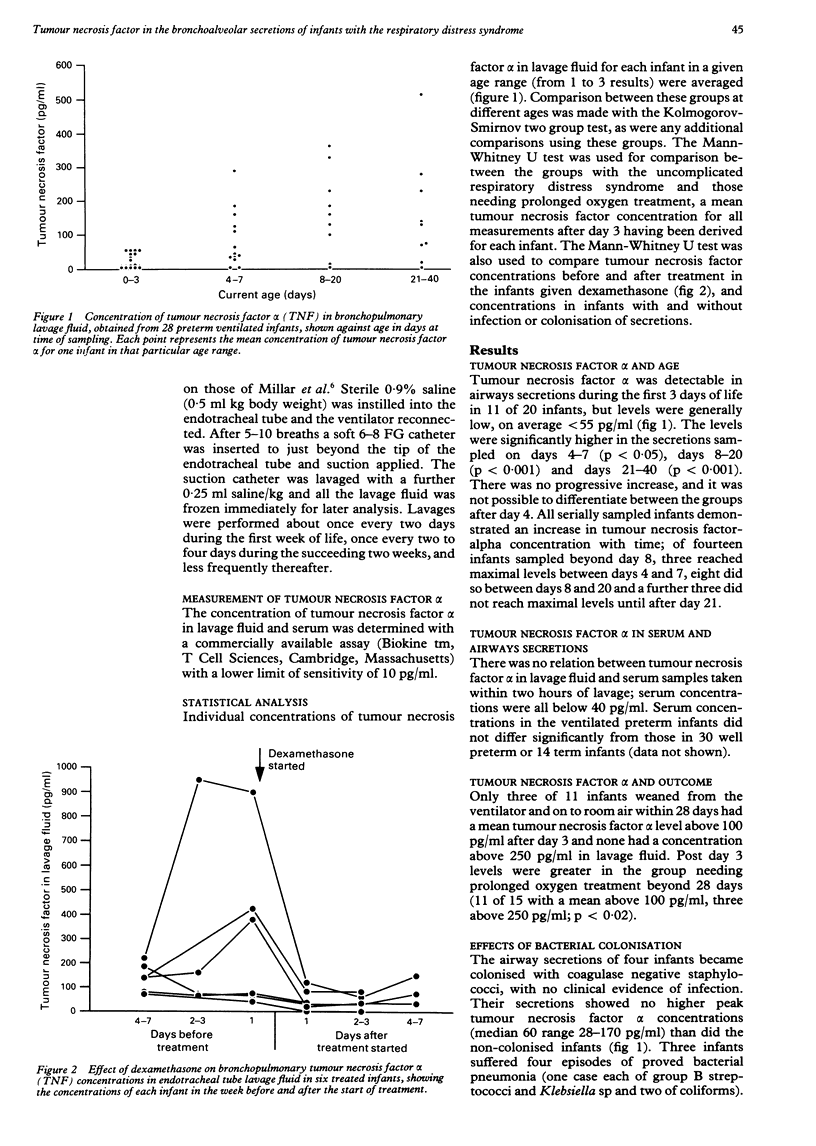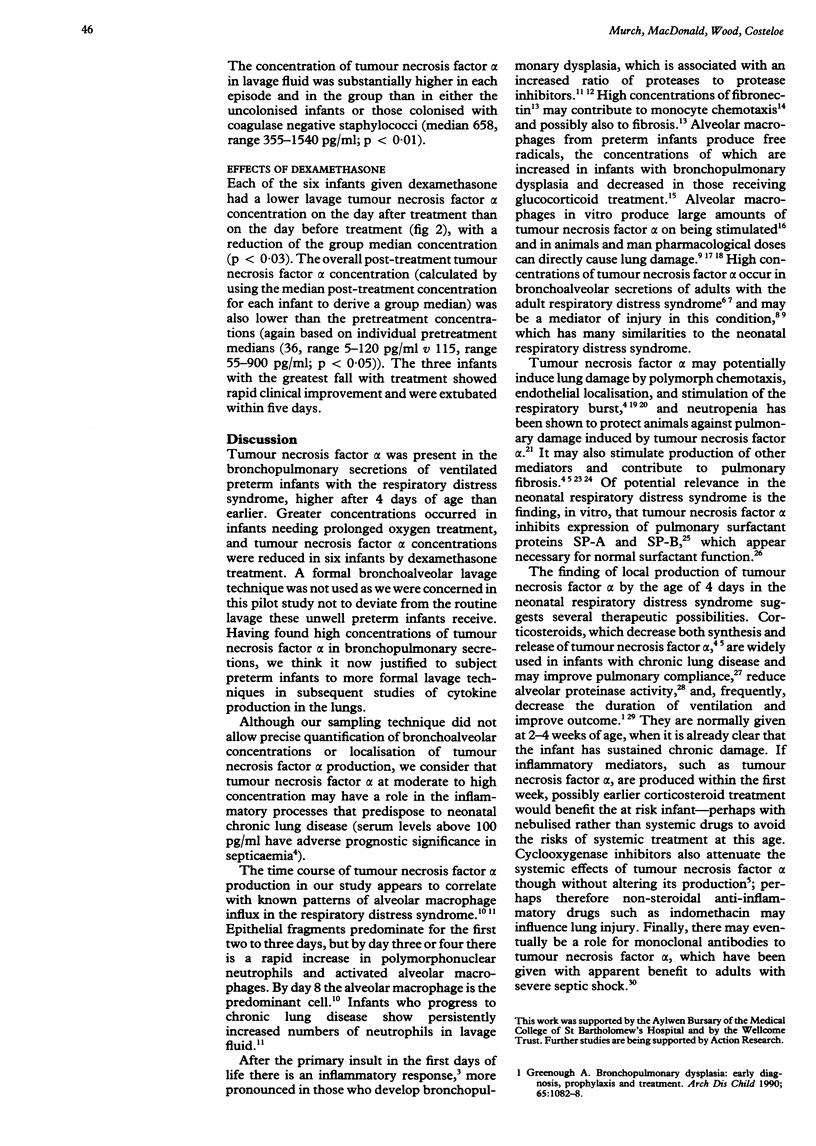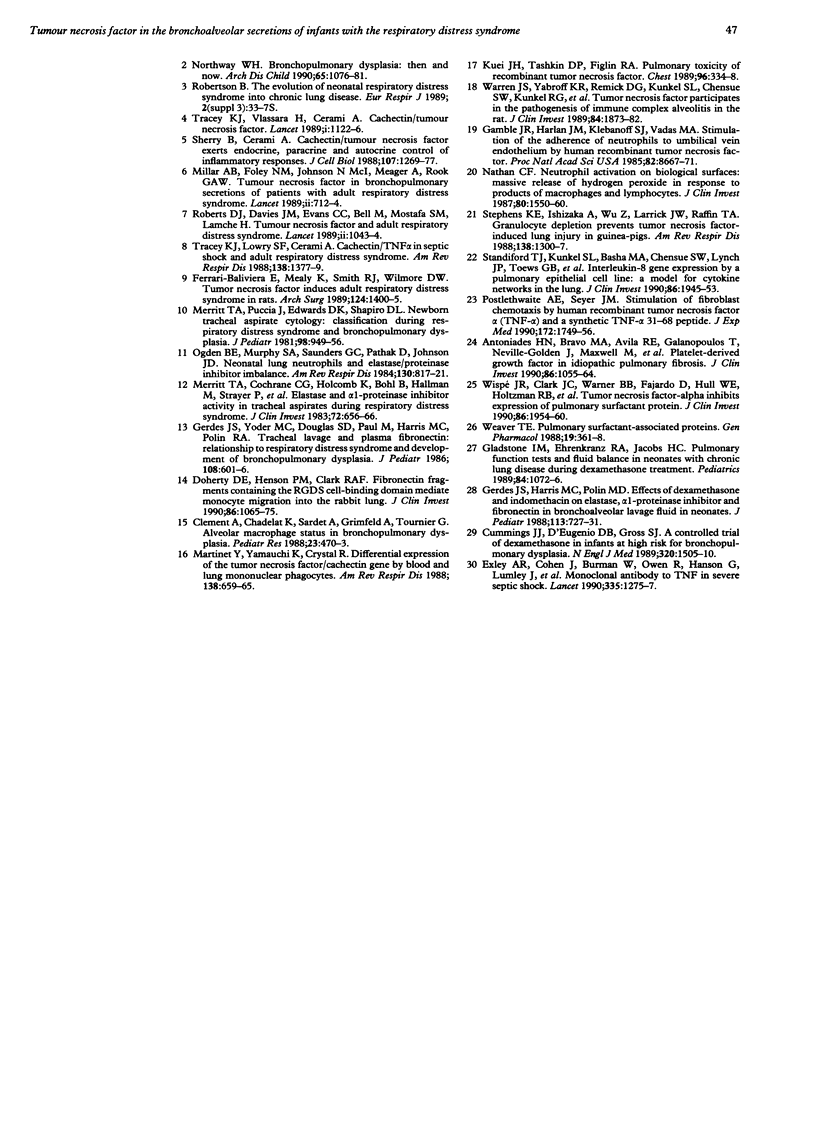Abstract
BACKGROUND: Tumour necrosis factor alpha may contribute to the lung damage that occurs in the adult respiratory distress syndrome. Whether it occurs in the lungs of preterm infants with respiratory distress syndrome is unknown. METHODS: Tumour necrosis factor alpha concentrations in the bronchopulmonary secretions of 28 ventilated preterm infants were determined by the enzyme linked immunosorbent assay. RESULTS: Concentrations were low in the first three days of life, being undetectable in nine of the 20 infants whose bronchopulmonary secretions were sampled. From day 4 concentrations were increased and detectable in all but two of 14 infants. Similar concentrations were found in samples taken on days 8-20 and 21-40. Greater mean concentrations occurred in those infants requiring oxygen for a long time. In six infants who received dexamethasone treatment for prolonged ventilator dependency treatment was associated with a reduction in tumour necrosis factor alpha concentrations. CONCLUSIONS: Tumour necrosis factor may contribute to the neonatal respiratory distress syndrome, as suggested for the adult respiratory distress syndrome. The therapeutic effects of dexamethasone treatment in neonatal respiratory distress syndrome may be mediated, at least in part, by reduced production of pulmonary tumour necrosis factor.
Full text
PDF



Selected References
These references are in PubMed. This may not be the complete list of references from this article.
- Antoniades H. N., Bravo M. A., Avila R. E., Galanopoulos T., Neville-Golden J., Maxwell M., Selman M. Platelet-derived growth factor in idiopathic pulmonary fibrosis. J Clin Invest. 1990 Oct;86(4):1055–1064. doi: 10.1172/JCI114808. [DOI] [PMC free article] [PubMed] [Google Scholar]
- Clement A., Chadelat K., Sardet A., Grimfeld A., Tournier G. Alveolar macrophage status in bronchopulmonary dysplasia. Pediatr Res. 1988 May;23(5):470–473. doi: 10.1203/00006450-198805000-00007. [DOI] [PubMed] [Google Scholar]
- Cummings J. J., D'Eugenio D. B., Gross S. J. A controlled trial of dexamethasone in preterm infants at high risk for bronchopulmonary dysplasia. N Engl J Med. 1989 Jun 8;320(23):1505–1510. doi: 10.1056/NEJM198906083202301. [DOI] [PubMed] [Google Scholar]
- Doherty D. E., Henson P. M., Clark R. A. Fibronectin fragments containing the RGDS cell-binding domain mediate monocyte migration into the rabbit lung. A potential mechanism for C5 fragment-induced monocyte lung accumulation. J Clin Invest. 1990 Oct;86(4):1065–1075. doi: 10.1172/JCI114809. [DOI] [PMC free article] [PubMed] [Google Scholar]
- Exley A. R., Cohen J., Buurman W., Owen R., Hanson G., Lumley J., Aulakh J. M., Bodmer M., Riddell A., Stephens S. Monoclonal antibody to TNF in severe septic shock. Lancet. 1990 May 26;335(8700):1275–1277. doi: 10.1016/0140-6736(90)91337-a. [DOI] [PubMed] [Google Scholar]
- Ferrari-Baliviera E., Mealy K., Smith R. J., Wilmore D. W. Tumor necrosis factor induces adult respiratory distress syndrome in rats. Arch Surg. 1989 Dec;124(12):1400–1405. doi: 10.1001/archsurg.1989.01410120046010. [DOI] [PubMed] [Google Scholar]
- Gamble J. R., Harlan J. M., Klebanoff S. J., Vadas M. A. Stimulation of the adherence of neutrophils to umbilical vein endothelium by human recombinant tumor necrosis factor. Proc Natl Acad Sci U S A. 1985 Dec;82(24):8667–8671. doi: 10.1073/pnas.82.24.8667. [DOI] [PMC free article] [PubMed] [Google Scholar]
- Gerdes J. S., Harris M. C., Polin R. A. Effects of dexamethasone and indomethacin on elastase, alpha 1-proteinase inhibitor, and fibronectin in bronchoalveolar lavage fluid from neonates. J Pediatr. 1988 Oct;113(4):727–731. doi: 10.1016/s0022-3476(88)80390-1. [DOI] [PubMed] [Google Scholar]
- Gerdes J. S., Yoder M. C., Douglas S. D., Paul M., Harris M. C., Polin R. A. Tracheal lavage and plasma fibronectin: relationship to respiratory distress syndrome and development of bronchopulmonary dysplasia. J Pediatr. 1986 Apr;108(4):601–606. doi: 10.1016/s0022-3476(86)80847-2. [DOI] [PubMed] [Google Scholar]
- Gladstone I. M., Ehrenkranz R. A., Jacobs H. C. Pulmonary function tests and fluid balance in neonates with chronic lung disease during dexamethasone treatment. Pediatrics. 1989 Dec;84(6):1072–1076. [PubMed] [Google Scholar]
- Greenough A. Bronchopulmonary dysplasia: early diagnosis, prophylaxis, and treatment. Arch Dis Child. 1990 Oct;65(10 Spec No):1082–1088. doi: 10.1136/adc.65.10_spec_no.1082. [DOI] [PMC free article] [PubMed] [Google Scholar]
- Kuei J. H., Tashkin D. P., Figlin R. A. Pulmonary toxicity of recombinant human tumor necrosis factor. Chest. 1989 Aug;96(2):334–338. doi: 10.1378/chest.96.2.334. [DOI] [PubMed] [Google Scholar]
- Martinet Y., Yamauchi K., Crystal R. G. Differential expression of the tumor necrosis factor/cachectin gene by blood and lung mononuclear phagocytes. Am Rev Respir Dis. 1988 Sep;138(3):659–665. doi: 10.1164/ajrccm/138.3.659. [DOI] [PubMed] [Google Scholar]
- Merritt T. A., Cochrane C. G., Holcomb K., Bohl B., Hallman M., Strayer D., Edwards D. K., 3rd, Gluck L. Elastase and alpha 1-proteinase inhibitor activity in tracheal aspirates during respiratory distress syndrome. Role of inflammation in the pathogenesis of bronchopulmonary dysplasia. J Clin Invest. 1983 Aug;72(2):656–666. doi: 10.1172/JCI111015. [DOI] [PMC free article] [PubMed] [Google Scholar]
- Merritt T. A., Stuard I. D., Puccia J., Wood B., Edwards D. K., Finkelstein J., Shapiro D. L. Newborn tracheal aspirate cytology: classification during respiratory distress syndrome and bronchopulmonary dysplasia. J Pediatr. 1981 Jun;98(6):949–956. doi: 10.1016/s0022-3476(81)80603-8. [DOI] [PubMed] [Google Scholar]
- Millar A. B., Foley N. M., Singer M., Johnson N. M., Meager A., Rook G. A. Tumour necrosis factor in bronchopulmonary secretions of patients with adult respiratory distress syndrome. Lancet. 1989 Sep 23;2(8665):712–714. doi: 10.1016/s0140-6736(89)90772-1. [DOI] [PubMed] [Google Scholar]
- Multicentre randomised clinical trial of chorion villus sampling and amniocentesis. First report. Canadian Collaborative CVS-Amniocentesis Clinical Trial Group. Lancet. 1989 Jan 7;1(8628):1–6. [PubMed] [Google Scholar]
- Nathan C. F. Neutrophil activation on biological surfaces. Massive secretion of hydrogen peroxide in response to products of macrophages and lymphocytes. J Clin Invest. 1987 Dec;80(6):1550–1560. doi: 10.1172/JCI113241. [DOI] [PMC free article] [PubMed] [Google Scholar]
- Northway W. H., Jr Bronchopulmonary dysplasia: then and now. Arch Dis Child. 1990 Oct;65(10 Spec No):1076–1081. doi: 10.1136/adc.65.10_spec_no.1076. [DOI] [PMC free article] [PubMed] [Google Scholar]
- Ogden B. E., Murphy S. A., Saunders G. C., Pathak D., Johnson J. D. Neonatal lung neutrophils and elastase/proteinase inhibitor imbalance. Am Rev Respir Dis. 1984 Nov;130(5):817–821. doi: 10.1164/arrd.1984.130.5.817. [DOI] [PubMed] [Google Scholar]
- Postlethwaite A. E., Seyer J. M. Stimulation of fibroblast chemotaxis by human recombinant tumor necrosis factor alpha (TNF-alpha) and a synthetic TNF-alpha 31-68 peptide. J Exp Med. 1990 Dec 1;172(6):1749–1756. doi: 10.1084/jem.172.6.1749. [DOI] [PMC free article] [PubMed] [Google Scholar]
- Roberts D. J., Davies J. M., Evans C. C., Bell M., Mostafa S. M., Lamche H. Tumour necrosis factor and adult respiratory distress syndrome. Lancet. 1989 Oct 28;2(8670):1043–1044. doi: 10.1016/s0140-6736(89)91058-1. [DOI] [PubMed] [Google Scholar]
- Sherry B., Cerami A. Cachectin/tumor necrosis factor exerts endocrine, paracrine, and autocrine control of inflammatory responses. J Cell Biol. 1988 Oct;107(4):1269–1277. doi: 10.1083/jcb.107.4.1269. [DOI] [PMC free article] [PubMed] [Google Scholar]
- Standiford T. J., Kunkel S. L., Basha M. A., Chensue S. W., Lynch J. P., 3rd, Toews G. B., Westwick J., Strieter R. M. Interleukin-8 gene expression by a pulmonary epithelial cell line. A model for cytokine networks in the lung. J Clin Invest. 1990 Dec;86(6):1945–1953. doi: 10.1172/JCI114928. [DOI] [PMC free article] [PubMed] [Google Scholar]
- Stephens K. E., Ishizaka A., Wu Z. H., Larrick J. W., Raffin T. A. Granulocyte depletion prevents tumor necrosis factor-mediated acute lung injury in guinea pigs. Am Rev Respir Dis. 1988 Nov;138(5):1300–1307. doi: 10.1164/ajrccm/138.5.1300. [DOI] [PubMed] [Google Scholar]
- Tracey K. J., Lowry S. F., Cerami A. Cachetin/TNF-alpha in septic shock and septic adult respiratory distress syndrome. Am Rev Respir Dis. 1988 Dec;138(6):1377–1379. doi: 10.1164/ajrccm/138.6.1377. [DOI] [PubMed] [Google Scholar]
- Warren J. S., Yabroff K. R., Remick D. G., Kunkel S. L., Chensue S. W., Kunkel R. G., Johnson K. J., Ward P. A. Tumor necrosis factor participates in the pathogenesis of acute immune complex alveolitis in the rat. J Clin Invest. 1989 Dec;84(6):1873–1882. doi: 10.1172/JCI114374. [DOI] [PMC free article] [PubMed] [Google Scholar]
- Weaver T. E. Pulmonary surfactant-associated proteins. Gen Pharmacol. 1988;19(3):361–368. doi: 10.1016/0306-3623(88)90029-8. [DOI] [PubMed] [Google Scholar]
- Wispé J. R., Clark J. C., Warner B. B., Fajardo D., Hull W. E., Holtzman R. B., Whitsett J. A. Tumor necrosis factor-alpha inhibits expression of pulmonary surfactant protein. J Clin Invest. 1990 Dec;86(6):1954–1960. doi: 10.1172/JCI114929. [DOI] [PMC free article] [PubMed] [Google Scholar]


